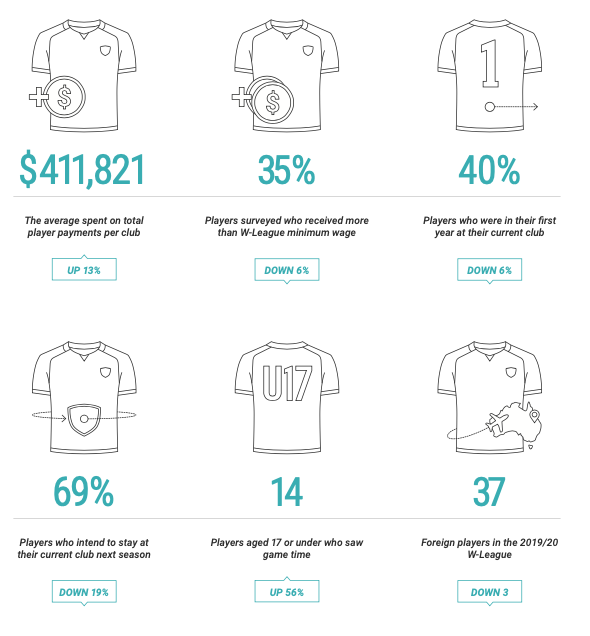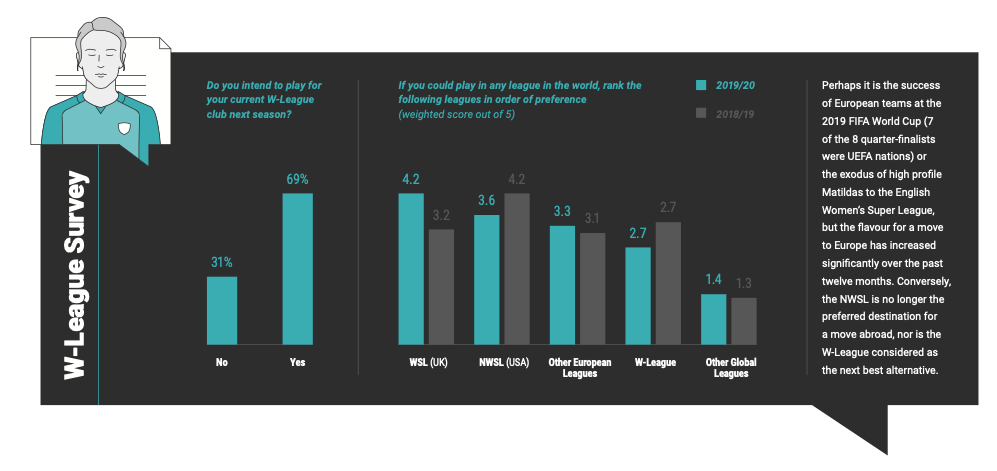The W-League risks being relegated to a third or fourth professional option for Australia’s female footballers, the Professional Footballers Australia (PFA) 2019/20 W-League Report reveals.
Published during a period of global uncertainty for female sport, the PFA’s fourth W-League report explores current trends affecting Australia’s elite-level female domestic competition and considers the W-League’s immediate strategic opportunities.
Click here to read the full report
A number of key findings from the Report include:
- Australian female professionals are no longer looking to the US National Women’s Soccer League to pursue careers, with Australians abroad now targeting Europe as their preferred destination
- Only two Australians remain contracted in the NWSL, down from 14 in 2019, with 93 per cent of Australians abroad now based in Europe, up from 39 per cent this time last year
- American players continue to gravitate towards careers in the W-League, indicating a symbiotic relationship with the NWSL remains a strategic prospect
- Regional centres are the heart of W-League player development with 40 per cent of the 2019/20 Australian-born W-League players developed in regional Australia
- The average club spend on total player payments is up 13 per cent from the 2018/19 season
- As Premiers and Champions, Melbourne City FC continues to lead the way in high performance and successfully integrating their W-League team into their club environment
Within the context of a global pandemic and with the football industry contracting, the Report suggests the W-League’s progress is likely to be challenged, particularly as the league contends with an exodus of elite talent to European clubs.

Based on industry trends, independent research, data and player feedback, the Report analyses four key components of the W-League; the Employment Framework, League Assessment, Technical Report and Injury Report, in a comprehensive review of the 2019/20 season.
PFA Co-Chief Executive Kathryn Gill said that the report indicates a more definitive long-term strategic purpose is required for the W-League.
“As the football economy contracts and considers its recovery from the economic fallout from Coronavirus, it is critical the W-League sharply defines its purpose in a rapidly evolving global context,” Gill said.
“With the emergence and attraction of European ‘powerhouse’ clubs and leagues, the W-League must consider its place within football’s ecosystem to ensure the career pathway for Australian footballers is dignified and legitimate.

“For example, is the W-League a world-leading development pathway designed to catapult our most talented players into the international market? Or is there an opportunity for the W-League and NWSL to work collaboratively to provide a calendar year of football and a partnership that serves both our international and domestic game?
“We must explore these options and ensure whatever approach we adopt, female football in Australia does not regress and the momentum of significant gains built over the past five years continues.”
The Report utilises data collated from Opta and via direct player feedback through the PFA’s major Annual Player Survey.







